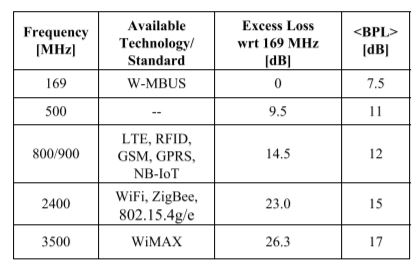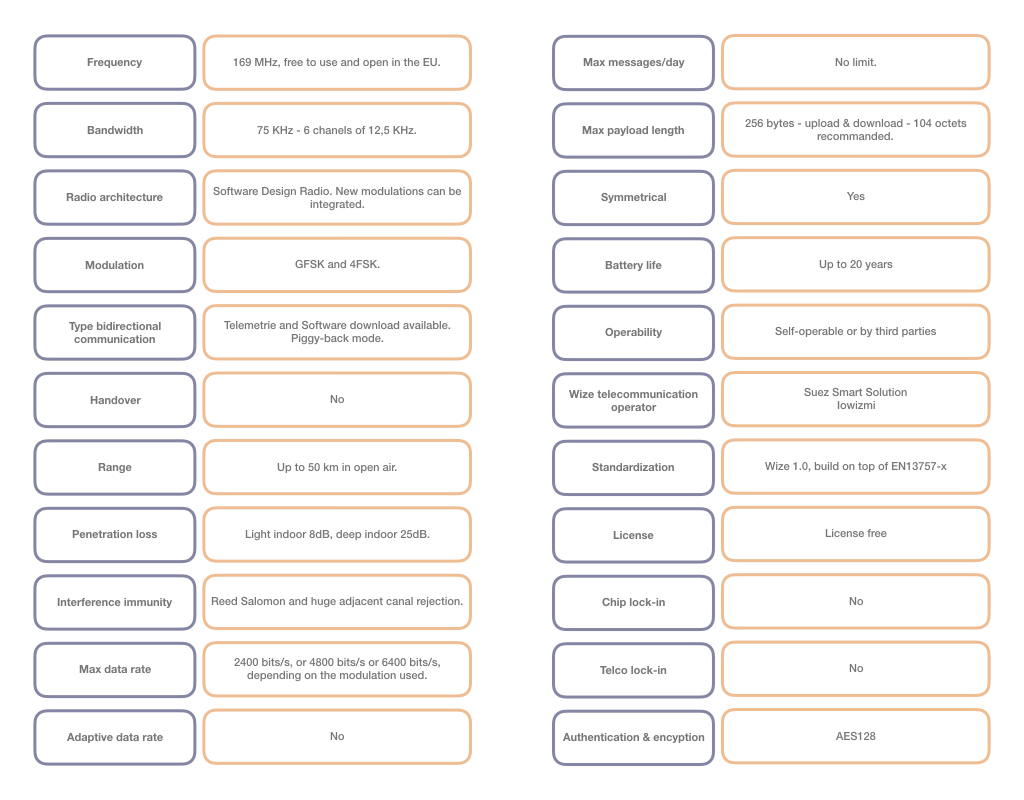Schedule a Teams Meeting with Radiocrafts or leave a message on our contact form to learn more about the impressive noise resilience, penetration properties, and range of the 169 MHz band and Wize!
169 MHz / Wize Smart Metering

Meters Located in Hard-To-Reach Places!
Benefits of the 169 MHz Band
The license-free 169 MHz frequency band is ideal for meters and sensors which are located in hard-to-reach places (deep inside buildings, basements, pits etc.) because the VHF frequency allows for deep building penetration and is less affected by obstacles and walls. The ultra-narrow bandwidth and high transmission power ensure good RF performance in terms of range and coverage, and interference and noise resilience. Despite the low frequency and high transmission power, it is possible to build compact devices with small antennas and small batteries with more than 15 years lifetime. It is the preferred technology for battery operated water and gas meters.
The physical properties of lower frequencies (169 MHz compared to 868 MHz) ensures the radio waves travel further, and have better penetration into buildings and “hard-to-reach” places. As a rule of thumb, a long wavelength (that is, a low frequency) will penetrate objects best, whereas a shorter wavelength (higher frequency) will slip through openings best.
The relatively low frequency combined with high transmission power (up to 500 mW) of the 169 MHz band, enables radio communication at long range. In addition, narrow band radio (12.5 or 25 kHz) is used to get the best radio receiver sensitivity. A communication range of 3-4 km in urban environments has been demonstrated using ultra-narrowband radio modules at 169 MHz (see Radiocrafts Application Note AN021).
The table below shows the free space excess loss for different frequencies with respect to 169 MHz, together with the related mean value of the Building Penetration Loss (BPL). As you can see, the increasing propagation loss with increasing frequencies impacts coverage and network performance. Additionally, this effect would be even stronger if we measured the propagation in a real environment instead of in an ideal free space condition. Many experts have done experiments in this field which have been picked up by various different authors and are summarized in this IEEE document[1].

Another main benefit of 169 MHz based radio is the simplicity and reliability of the point-to-point network, and hence reduction of operational cost. The devices operating in the 169 MHz band do not require any repeaters. The drawback of technologies using repeaters or mesh technology is the installation and maintenance of such repeaters, and the higher power consumption of mesh networking devices. Gas and water meters do not have access to mains power and must run off batteries. This prevents the meters to act as a router in a mesh network. Establishing dedicated routers or repeaters is complicated with respect to getting access to installation sites and access to mains power at these sites, as well as the maintenance of such devices.
Furthermore, the 169 MHz band is less congested than the more popular higher frequency bands which improves reliability significantly and multiple channels are available.
To learn more about the 169 MHz frequency band, please read our White Paper 011 here.
Summary of the 169 MHz benefits:
- Narrowband radio, using 12.5 kHz channels increase the sensitivity
- Low data rate (2.4/4.8/6.4 kbps) increase sensitivity
- Narrowband radio also improves the selectivity, reducing interference and blocking
- High RF transmission power, up to 500 mW of radiated power is allowed in this band and provides a significant increase in range
- The relatively low frequency at 169 MHz gives good penetration in buildings and deflects around obstacles
- The relatively low frequency yields a lower path loss due to larger antenna area (but means the antenna structure will be larger)
The Wize Technology
Wize, promoted by the Wize Alliance, is a 169 MHz IIoT technology designed to achieve long range, great object penetration, and long battery life. It is based on Wireless M-Bus mode N and has been used in millions of gas and water meters in commercial operation for several years.
Wize has several benefits which include:

Based on a Proven European Standard, 13757-4

Designed For Hard-To-Reach Places

Simple Deployment Requirements

Low Maintenance

A Non-Crowded Spectrum

Over-The-Air Firmware Updates
- Based on a European Standard – The current version of Wize is based on the European standard 13757-4, defined by the European Union to accompany the deployment of communicating meters. Since the launch of Wize Alliance in 2017, the standard is open to other use cases for IoT. Read our White Paper on the relationship between Wireless M-Bus and WIZE here.
- Designed For Hard To Reach Places – The Wize technology operates in the 169 MHz band which allows for good RF performance in terms of building penetration (low building penetration loss), coverage (range of 50 km Line of Sight), and consumption of battery. Specifically designed to connect hard to access objects, Wize delivers secure information for Internet of Things applications for utilities, cities, industrial or tertiary sectors.
- Field Proven – Over the last 13 years, 6 million Wize enabled devices have been deployed in the field, in 15 countries and 500 cities. The Wize Alliance predicts that by 2021 there will be 15 million Wize enabled devices.
- Simple Deployment Requirements – The deployment of the network is simple and fast because the technology requires a minimum of equipment (a communicating object and a concentrator): no repeater system, no pairing or complex programming. The technology is already proven in many countries in Europe, Africa and Australia and it is rather easy to deploy a network on a large scale.
- Low Maintenance – The Wize technology can connect to meters which are energy-efficient enough to last a very long time (typically 15-20 years). Additionally, since the technology requires a minimum of equipment, it facilitates the operating and maintenance costs.
- A Non-Crowded Spectrum – The 169 MHz band is less utilized than 868 MHz for example, providing better reliability and less interference. Communication from one meter to the gateway is carried out in broadcast mode in both directions which allows multiple gateways to receive the same message from a single meter. Therefore, this system increases the performance of the radio solution by providing redundancy and high availability in the system.
- Over-The-Air Firmware Updates – bi-directional communication and over-the-air firmware updates are supported by Wize.

Radiocrafts’ Involvement In The Standardization Process of 169 MHz Radio Solutions
Radiocrafts has been a pioneer in the standardization and development of radio solutions in the 169 MHz band with several hundreds of thousands of modules already deployed.
Radiocrafts has been an active member of the CEN TC294 standardizing the use of 169 MHz in Europe for many years. This group works in the standardization of communication interfaces for systems with meters and remote reading of meters for all kind of fluids and energies distributed by network. The use of 169 MHz for metering applications was first standardized in the EN 13757-4:2013. The new N mode defined 6 channels in the VHF band, and combined low bandwidth (12.5 kHz) and high transmission power (500 mW) to achieve a superior radio performance. The 169 MHz band is not limited to metering applications, but also other types of sensors can take benefit from this technology. Industrial wireless sensor networks can use this technology to improve the robustness and reliability of the radio link.
Radiocrafts is also an active contributing member of the Wize Alliance.
Radiocrafts can also assist in design of 169 MHz equipment, we have a long experience in antenna and power management designs needed for a successful design project. Read our Application Note on tuning a 169 MHz antenna here.
Radiocrafts' 169 MHz/Wize Modules For Smart Metering
Radiocrafts has a high quality 169 MHz product portfolio that will ensure your solution is accepted in the market, is well proven, reliable, and secure, using the best industrial practices to meet Smart Metering requirements.
- RC1701HP-MBUS4 – module which supports Wireless M-Bus Mode N (Datasheet)
- RC1701HP-MPC1 – module with pulse counter, tamper, and install inputs (Datasheet)
- RC1701HP-MSM – module with integrated sensor interfaces (Datasheet)
- RC1701HP-WIZE – module based on the Wize protocol, and is specially designed for deployments where the gas meter / water meter /sensors are located in hard-to-reach places (Datasheet)
- RC1702HP – module is used as a versatile customizable hardware platform which can be an autonomous system (no external MCU required) running the full application code. For example, battery operated water and gas meters (Datasheet)

The RC1702HP module has several optional peripherals (EEPROM, 32 kHz crystal oscillator) and interfaces.
Some examples of external peripherals that have been supported in various customized applications include:
- IRDa interface for local communication
- NFC interface for local communication
- Interface to RTC (real time clock) chip for timekeeping / calendar
- External EEPROM memory for storing firmware image for over-the-air updates
- Pulse inputs with counters (forward and reverse) for mechanical water and gas meters
- SPI interface to metrology controller or sensor
- I2C interface to sensors
- Digital inputs for tamper alarm switch of Hall sensor
- Battery voltage supervision using the ADC
Radiocrafts will provide full application circuits for the external peripherals (IRDa, NFC, RTC, EEPROM etc).
The module has been used in several smart metering applications successfully implementing ultra-low power operation with 15 years battery lifetime on single AA-cell.
Schedule a Teams Meeting with Radiocrafts or leave a message on our contact form to learn more about the impressive noise resilience, penetration properties, and range of the 169 MHz band and Wize!
